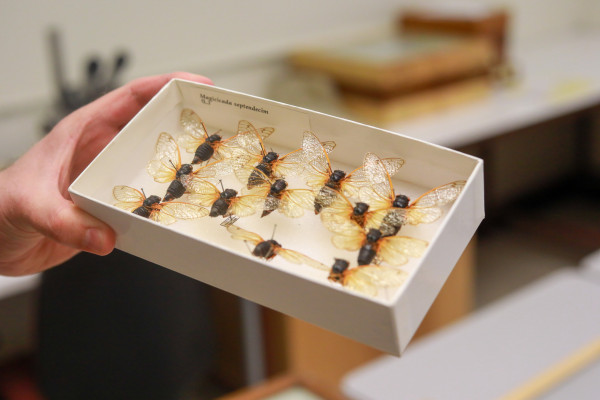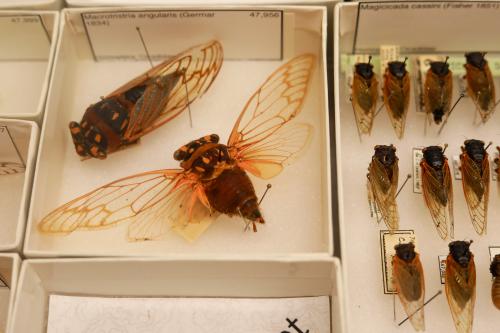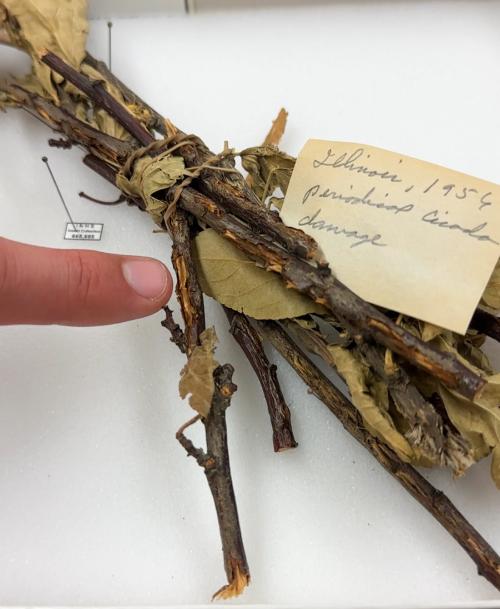Cicadas in CU: What to Know and Where to Find Them

As the temperatures rise and the days grow longer, a natural spectacle unfolds in Champaign-Urbana and its surrounding areas. It’s a phenomenon that occurs only once every 13 or 17 years, captivating the attention of residents, scientists, and nature enthusiasts alike. The stage is set for the grand emergence of periodical cicadas (genus Magicicada) that will inhabit Eastern North America in the coming weeks!
While it’s an exciting time for us locals, our friends over at the Illinois Natural History Survey Insect Collection at the University of Illinois have hit a research gold mine—there is still much to learn about these fascinating insects. We stopped by at the Natural Resources Building at the University of Illinois to get more insight on the cicadas, where to find them, how to contribute to their research, where to celebrate this momentous occasion, and much more!
Main Image: The oldest recorded cicada specimens at the Illinois Natural History Survey Insect Collection, dating back to 1894!
 WHERE CAN WE FIND THE CICADAS?
WHERE CAN WE FIND THE CICADAS?
Fortunately for us, over a trillion cicadas are waiting to emerge right below our feet. In the Champaign-Urbana area, we are at the northern end of the Great Southern Brood, and the southern edge of the Great Northern Brood. Over at Allerton Park and Retreat Center, we can already see emergence holes, where the cicadas will sit close to the surface before burrowing out.
WHEN SHOULD WE EXPECT THE EMERGENCE?
In the state of Illinois, we should expect to see the cicadas emerge around mid May, as the ground temperature stays at or above 64 degrees. In the middle to end of May and beginning of June, trillions of cicadas will take flight to perform mating rituals that will last for about a month before dying off. The first adult cicadas are emerging in southern and middle Illinois as of May 2nd!
WHAT’S WITH ALL THE NOISE?
The male cicadas are responsible for the symphony of sounds. These sounds are mating calls for the females—the louder the noise, the better the chance they get to mate.
DO BROODS INTERMIX?
Fascinatingly enough, researchers aren’t totally sure. The last time a 13 year brood and a 17 year brood emerged closely adjacent to each other was in 1803—Illinois wasn’t a state yet! They are not expected to intermix, as different broods have specific mating calls, and there’s quite a lot of distance between broods. The closest these two broods will overlap is in Sangamon County, where they are only separated by a few dozen miles.
WHAT MAKES ILLINOIS SO SPECIAL TO WITNESS THE EMERGENCE?
We are one of the only states in the U.S. that houses all seven species of periodical cicadas. If you’re feeling ambitious, you can witness all species within a year, which according to researchers, is something of an anomaly in the entomology world. You can see all three of the 17-year species in the Chicago area, and all of the 13-year species in the southern Illinois area.
Pictured: Cicada specimens from the INHS Insect collection
ARE CICADAS SAFE TO HANDLE?
Yes! Cicadas are not harmful to humans and have no jaws or mandibles. You can gently pick them up by their sides—the most they will do is vibrate and make noise. They also prefer to feed on tree roots and will do so for years before emerging out of the ground. During their emergence, they may suck on some sugary plant juices, but are more busy with other activities.
DO CICADAS CAUSE HARM TO OUR LOCAL ECOSYSTEM?
No! Cicadas are a huge benefit to our local ecosystem. They are a massive food source, providing an ample supply of protein and fat stores for wildlife. They are also harmless to mature plant life such as trees, although be wary of newly planted trees and shrubs, which can damage very fragile new saplings. Cicadas will lay their eggs right underneath tree bark, which may impact growth, but some research says that older trees actually benefit from this activity.
ASIDE FROM LOCATIONS, WHAT IS ONE THING RESEARCHERS WILL STUDY ABOUT THESE CICADAS?
There is a specific “zombie-like” fungus called Massospora cicadina that only attacks periodical cicadas (no need to fret, this fungus is completely harmless to humans). The fungus lives on the soil and will enter the cicada’s body as they emerge. The fungus will then germinate, take over its entire abdomen, and fill it with spores. The adult cicadas will then fly around and spread the spores to other cicadas that come in contact. Interestingly enough, the fungus will alter brain chemistry, making some infected males tolerate being mounted by other males, and both males and females will spend more time dragging infected abdomens on the ground, dispersing more spores.
Pictured: A sample of plant damage by periodical cicadas dating back to 1956
HOW CAN I HELP WITH RESEARCH?

Although there is a lot of information about periodical cicadas, they are still an anomaly to scientists because they are quite difficult to track down. You can help researchers map exactly where they are going to emerge by downloading the app, iNaturalist or CicadaSafari, and take photos, videos, or audio recordings of cicadas as you find them out in the wild.
Pictured: A gallery of user-submitted photos of periodic cicadas on iNaturalist.org
CELEBRATE THE GREAT EMERGENCE WITH THESE COMMUNITY EVENTS!
THE CICADA EMERGENCE CONVERGENCE FESTIVAL
BROOD XIX MEET-UP AT ALLERTON PARK
When: Saturday, June 1, 2024
Where: Allerton Park and Retreat Center (515 Old Timber Rd, Monticello, Illinois)
You can observe, do science, and marvel at the mass emergence of the cicadas over at Allerton Park from 10:00–4:00 p.m! There will be a variety of activities and displays, including:
- A talk with local cicada expert Katie Dana about Magicicadas
- Scream-like-a-Cicada Contest (Time TBD)
- Purchase limited release beer "Emergence Convergence" by Triptych Brewing
- Tables and Displays from: Entomology at UIUC - Insect Petting Zoo
- Live cicadas
- PRI Traveling Science Center
- And much more!
BROOD XIII MEET-UP AT THE NACHUSA GRASSLANDS
When: Sunday, June 2, 2024
Where: Nachusa Grasslands (2075 Lowden Road, Franklin, Illinois)
If you’re looking to travel outside of the Champaign-Urbana area, the INHS team will be doing a field study at the Nachusa Grasslands on Sunday, June 2, from 10:00–4:00 p.m! There will be an insect petting zoo and displays by the Peggy Notebaert Nature Museum.
INHS INSECT COLLECTION OPEN HOUSE CICADA EXTRAVAGANZA
When: Monday, June 3, 2024
Where: Illinois National History Survey, Room 296 (615 E. Peabody Dr.)
The INHS Insect Collection will be open to the public from 9:00–5:00 p.m, where you can see the cicada collection and get a behind-the-scenes tour of the facility! This event is open to the public and registration is not required.
Cicada Palooza at the Vault Gallery
Come celebrate the historic cicada emergence over at the Vault Art Gallery in Tuscola! Activities include:
- A presentation: The Emergence Convergence of periodical Cicadas: Why Illinois is the Place To Be This Year by Katie Dana, PhD Affiliate with the illinois Natural History Survey
- Activities such as painting rocks and musical tools for cicada sound-making
- Live acoustic tunes (anyone can join in or enjoy the music!)
- A cicada-themed parade
- Light refreshments
- And more!
JOIN IN ON THE FUN!
We invite you to take photos of any cicadas you come across during the great emergence. Be sure to tag us on Instagram and use the hashtag #CicadasInCU where you’ll be entered to win a Chambana Proud t-shirt of your choice!




